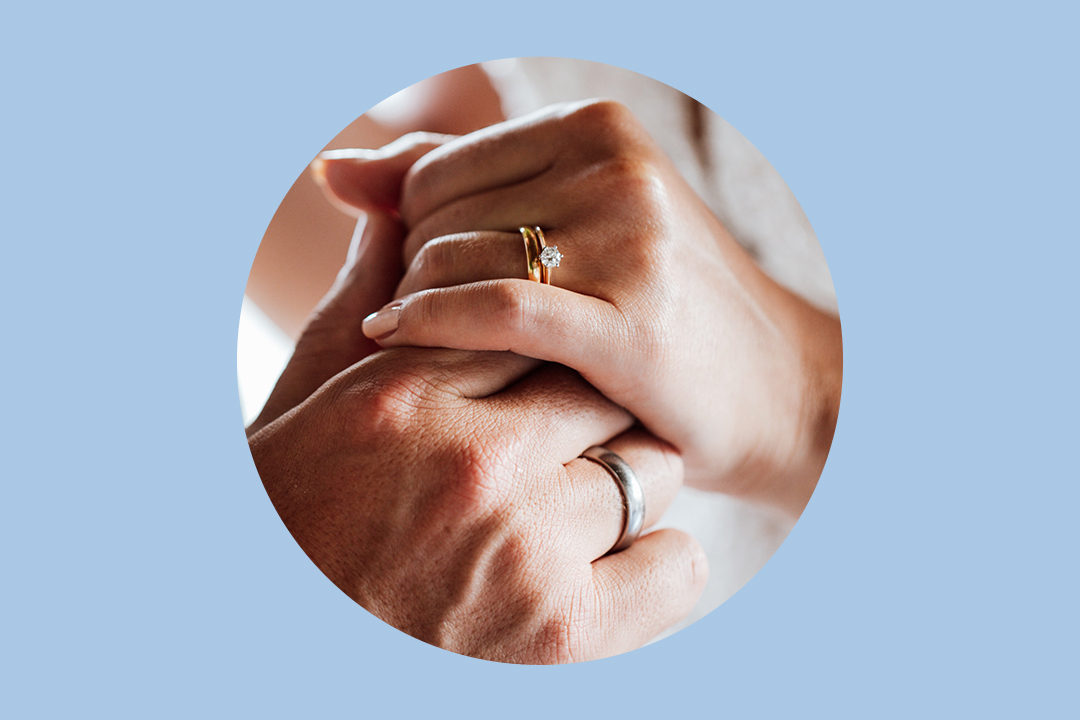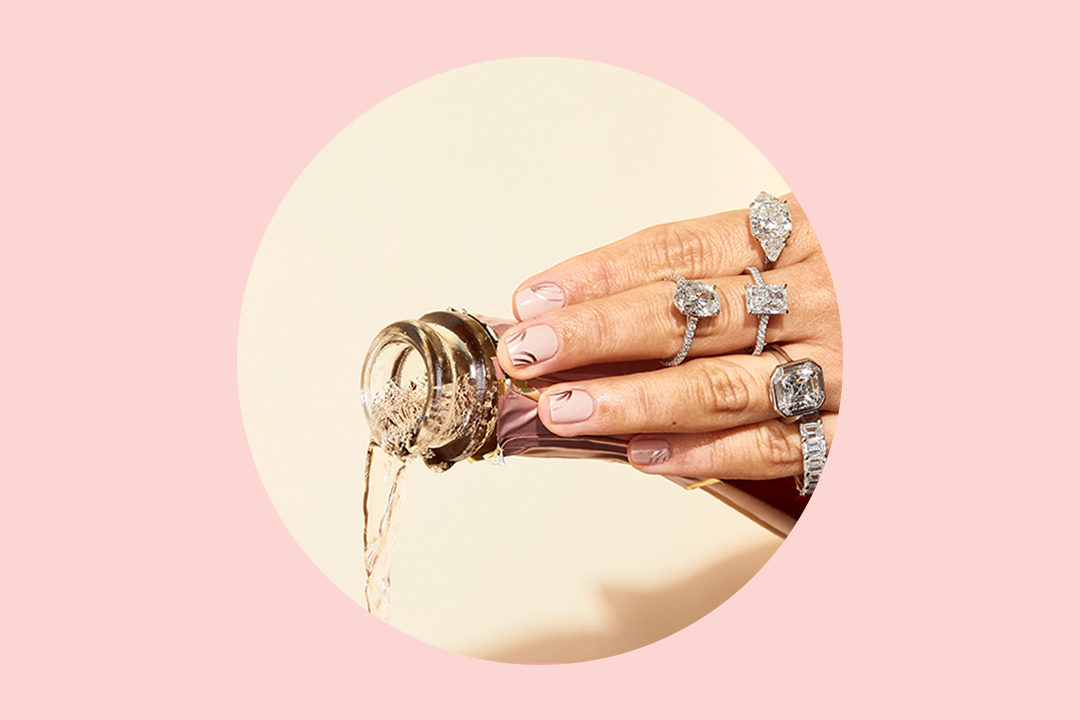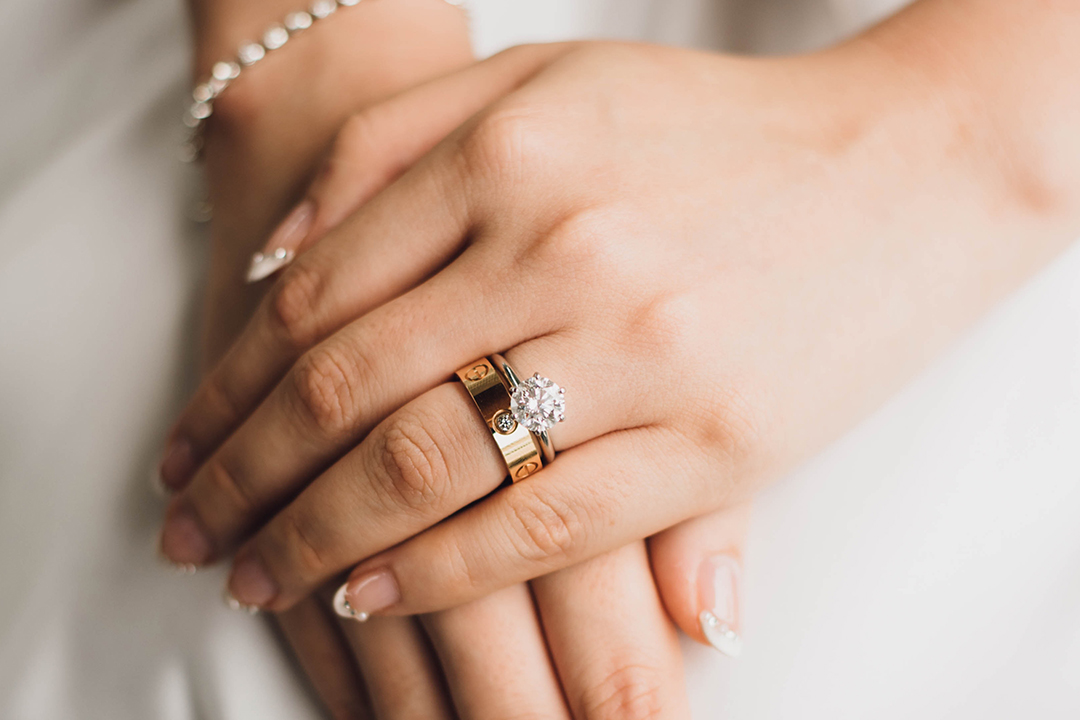- Expert advice/
- Getting engaged/
- Rings/
- Payment Plan for Your Wedding Rings
- Rings
Payment Plan for Your Wedding Rings
Financing your wedding rings can be a costly upfront investment. That’s why many jewelers offer wedding ring payment plans. Learn all about them here.
Last updated February 5, 2024

The First Look ✨
- Wedding rings are a big investment, but payment plans are an excellent option for couples who aren’t ready to pay the full cost upfront.
- Many jewelry stores offer their own financing options to delay payment anywhere from six to 12 months. Jewelers such as Jared’s, Blue Nile, and Reeds also offer credit cards with financing options, limited interest, and small annual fees.
- Don’t forget to choose a ring that aligns with your personal style! Zola offers a variety of fine jewelry and wedding rings to adorn your wedding day attire.
You can’t put a price tag on love, but, unfortunately, jewelers have put a rather hefty price tag on the symbols of your love: your wedding rings.
The price of rings and wedding bands adds up fast, especially when you consider how much money you’ll be spending on the rest of your wedding. To help you manage such a large purchase, you can opt for a wedding ring payment plan instead.
We’ve created a handy guide to walk you through financing your rings.
How to Finance Your Wedding Rings:
Do You Need to Have Wedding Rings?
No rule says you and your partner have to purchase wedding rings. Some married couples opt for matching tattoos, matching (less expensive) jewelry sets, or even a shared experience, such as planting a sapling together in your backyard.
If allocating funds for a ring budget doesn’t work for you, then it doesn’t work for you—that’s okay! You may prefer to use the money you’re saving on a two-week honeymoon or downpayment on a new house, or even a more expensive wedding venue. Zola has a stunning collection of pre-screened wedding venues with the option to search by price.
Your lifelong commitment doesn’t need bling to be real or meaningful. It just needs your love and excitement to start this amazing new chapter together.
How to Finance Your Wedding Rings
First things first: The average engagement ring costs around $4,000. Besides your house, car, and student loan payments, an engagement ring may be one of the bigger investments that you make in your life.
The average cost of a wedding band (the ring, not the music) in 2019 was $1,100 for women and $500 for men. While you may be able to find affordable wedding venues, caterers, photographers, and bands (both the rings and the music) at Zola, these costs can still add up—and fast.
There are several options when it comes to financing your wedding bands and engagement rings:
- Finance through the jewelry store.
- Use a credit card.
- Take out a personal loan.
Below, we’ll outline the details of each option. Then, we'll offer a few tips to help you decide which financial plan is best for you.
Jewelry Store Financing
Whether you’re perusing the cases at a mom-and-pop jeweler or browsing the sparkly displays at a national diamond retailer, chances are that you’ll be presented with the option to finance your ring through the shop itself.
Like credit card companies, jewelry stores will run zero percent interest promotions to encourage buyers to choose their bands over competitors.
This promotion may last for a period of six to 12 months (or longer), with no payments required for a set amount of time. But all of these deals have an expiration date (and fine print caveats!), so be sure to get all the pertinent information about the promo before agreeing to anything. Like most retailers, jewelry stores will also offer credit cards as a financing option.
Jewelry Store Credit Cards
From Jared’s to Blue Nile to Reeds, jewelry stores around the country offer credit cards with varying terms, interest rates, fees, and potential down payments.
Let’s compare these three companies to give you a sense of what the terms may look like for a jewelry store credit card:
-
Jared: Jared has several different credit cards to choose from. The Gold Card offers 12, 18, 36, and 48-month financing. Each financing option requires a minimum purchase amount, and both the 12 and 18-month options also require a 20 percent down payment that must be placed on a separate card. You can find out if you prequalify for this card online; most retail credit cards require a credit score of around 640.
-
Blue Nile: The Blue Nile card boasts no annual fees, as well as access to special card-member-only promotions. Minimum payments are required each month, no matter your plan; Blue Nile’s three options are:
-
Option 1 charges no interest if paid in full within six, 12, or 18 months. The six-month deal requires a minimum payment of $500, the 12-month minimum is $1,500, and the 18-month minimum is $2,000.
-
Option 2 is 9.99 perfect APR financing for 24, 36, 48, or 60 months. The minimums are, respectively, $2,000, $3,000, $4,000, and $6,000. After your allotted time span is up, the APR goes up to a whopping 28.99 percent.
-
Option 3 has no special terms, and new purchases are afforded a 25-day grace period if you pay your balance in full each month.
-
-
Reeds: The Reeds credit card works with a points system—cardholders earn three points for every $1 spent. That means a $1,000 purchase will get you $30 in rewards and so on. Reeds has two main financing options:
-
Option 1 is 9.99 percent APR for 60 months with a minimum purchase of $2,000.
-
Option 2 is no interest, if paid in full within 6 months (minimum purchase of $299) or 12 months (minimum purchase of $1,000).
-
So, is taking out a jewelry store credit card in your best financial interest? Maybe not.
While applying for a retail credit card can help you keep your credit varied (a consideration when calculating your credit score) it can also saddle you with hefty interest rates. However, retail credit cards are usually easier to obtain than other financing plans, and they’re certainly convenient—you’re buying and borrowing from the same place.
When deciding on a wedding ring payment plan, consider your track record with other credit cards:
-
Are you able to make monthly payments on time for your current bills?
-
Will you have enough funds to pay off your ring or rings within the timeframe of the store’s promotional period?
If the answer is “no” to either of these questions, you may want to consider another form of financing for your wedding rings.
Credit Card Financing
Couples shopping for wedding rings may choose to go with a traditional credit card financing method.
Opening up a new card with a zero percent introductory APR is a popular choice. To qualify for cards with this interest rate, you will typically need a good (to excellent) credit score in the range of 670 or higher.
If your credit score falls within this range, here are a few questions to ask yourself before applying for that shiny new card:
- How long is the introductory rate period?
- What APR will you pay when this period is over?
- Does the zero percent interest apply to all transactions?
- Are there any fees?
- Can I make monthly payments within the introductory period to pay off the ring before the interest rate goes up?
These cards not only help you with this one-time ring purchase, but they can also be beneficial to your overall credit and financial well-being.
When used responsibly, a zero percent APR credit card can:
-
Help you with your credit utilization ratio: Credit utilization accounts for 30 percent of your FICO credit score. This means that the more you owe per credit card, the more your credit score may be affected. If you can balance out your debt on several cards, keeping the balance low, your credit utilization ratio will be low and less likely to hurt your credit.
-
Improve your credit mix: If you’ve shied away from credit cards in the past, this is a great chance to add variety to your credit mix in a responsible manner. Your credit mix accounts for 10 percent of your FICO score.
-
Help you reduce debt: In addition to helping you fund this monumental purchase, zero percent APR cards can also help you reduce your debt. If you owe a high balance on another card with a high interest rate, you might feel like you’ll never get that card paid off. By transferring your high debt to your new zero percent interest rate card, you’ll be saving potentially hundreds, if not thousands, of dollars in saved interest.
Many people choose to add another credit card to their collection because there are quite a few options available for zero percent APR cards.
Here are just a few of the best zero percent APR credit cards currently on the market:
Best 20 months: The U.S. Bank Visa Platinum card gives you 20 months—almost two years—of zero percent interest on balance transfers and purchases. You can finance your rings and transfer hefty debt from another card if you choose. There’s also no annual fee attached. The regular APR will go up to 13.99-23.99 percent after the introductory period.
Best 18 months: The Citi Simplicity card features zero percent interest on balance transfers and purchases, with the regular APR going up to 14.74-24.74 percent after 18 months. There’s no annual fee, and balances can be transferred within four months of the account opening, which is a generous timeline compared to other cards.
Best cashback: The Discover It Cash Back card features a zero percent interest rate on balance transfers and purchases for 14 months with zero annual fees. This card also boasts impressive cashback rewards; you earn five percent cashback on rotating “bonus categories,” plus one percent back on all spending. The first year you also earn Discover’s new cardholder bonus. The interest rate on this card goes up to 11.99-22.99 percent APR after the introductory period.
As you can see, the greatest boon of choosing a zero percent APR credit card to finance your wedding rings is that this card can be used for a myriad of other purchases and balance transfers, too, potentially improving your financial well-being as you head into married life.
Personal Loan Financing
If you and your significant other don’t qualify for jewelry store financing or a zero percent APR credit card, taking out a personal loan is another option to finance your wedding rings.
Personal loans are usually easier to obtain if you have a lower credit score, but be wary of high interest rates. The average personal loan period is anywhere from 12 to 60 months, but you’ll want to try and pay off the loan in the shortest amount of time to avoid accruing too much interest.
If you just can’t wait to get your hands on those sparkly, delicate wedding rings, take a second and consider the following tips before taking out that personal loan to pay for them:
-
Figure out how much you can realistically pay every month: Calculate your monthly bill payments—your spending on necessities such as groceries and toiletries, your emergency fund, and your allotment for “fun” purchases such as going out to dinner or your favorite daily coffee drink, and finally, the budget for your entire wedding. After doing the math, decide on a monthly payment that you can reasonably afford for your rings. Keep that number in mind when you’re shopping around for both rings and financing options.
-
Compare all loan options: Don’t just look at the interest rates when choosing a personal loan. Be sure to compare interest, fees, and the terms of the payment plan when choosing your personal loan. For instance, let’s say the interest rate is wonderfully low, but the payment plan requires you to pay off the purchase in under six months. You may not be able to swing a higher monthly payment toward the loan in that short amount of time.
-
Use a credit calculator: The best way to get an idea of what your monthly ring payment will be is to use a credit calculator. A free online calculator will use the price of your engagement ring, the interest rate of your loan, your credit score, and your loan term to determine your minimum monthly payments and the additional interest you’ll pay in using this particular option.
Experts urge that no matter which wedding ring payment plan you land on, try to avoid spending outside of your means. Paying for gorgeous bling may be tempting in the moment, but will you want to be funding that platinum band for a decade?
Choosing the Perfect Wedding Ring
Now that we’ve waded through the intricacies of finances and budgeting for a ring, let’s get to the fun part: picking the rings.
Whether you have an exact ring in mind or just a vague idea of what you like, create a separate “must-have” list of qualities for the rings themselves. Continue to compare and contrast these two documents as you get closer to your purchase date—and big day.
If you’re a little lost as to what exactly you want in a ring, ask yourself the following questions:
-
How will your ring fit into your lifestyle? Some people keep their jewelry on when they hit the gym, pool, or shower. If you plan to wear your wedding band day in and day out, you may want to choose rings that are made with more practical materials such as palladium, titanium, tungsten, or silicon, so that you can demonstrate your love without damaging your ring.
-
Which ring style speaks to you? Study up on the different available ring styles. Even if you aren’t sure what the exact terminology is for a certain style and setting, or even why you're drawn to it, you’ll have an easier time communicating at the jewelry store if you know what gives you that warm, exciting feeling. Some popular styles include vintage Art Deco and mixed metals, and settings range from infinity setting to a solitaire setting.
Zola tip: Before your appointment, browse Zola’s extensive line-up of wedding bands. You can search based on material, brand, color, and price to get a better sense of what you love (and what you don’t).
- Will you have an engagement ring and wedding band? If you or your partner plan to wear both a wedding band and engagement ring, think about how these two pieces of jewelry will interact. They don’t need to match, necessarily, but make sure that they’ll fit comfortably. If your engagement ring features several diamonds or stones, you may not want a band that is too thick or one that is set with prominent stones as they may rub against your bottom ring.
Shop Wedding Rings and More at Zola
Zola has a multitude of resources to help you plan and execute everything from your engagement to your wedding day. If you’re carefully budgeting for wedding rings plus the wedding itself, you won’t want to stress over creating a beautiful wedding website, choosing one-of-a-kind invitations, or finding quality vendors in your price range.
Zola takes care of all this for you, with more than 300 wedding website templates, customizable wedding invitations, and plenty of pre-screened wedding vendors to choose from. And, if you decide that financing your rings just isn’t worth it for you, Zola has highly affordable wedding rings that you can browse—no APR, credit check, or monthly payments necessary.
Ready to streamline the wedding planning process? Check out Zola.
Sources:
Up next for you

Where You Can (and Can't) Wear Your Engagement Ring
Inspiration
Diamond experts share all the places you can wear your engagement ring and where you shouldn't wear your ring. Plus, tips for keeping your engagement ring like new.

A Guide to Wedding Rings
Inspiration
From how much you should expect to spend on a wedding ring to tips for how to choose the right one for you, check out this guide on wedding ring styles, types, and materials.
Featured

50 Best Engagement Party Ideas of 2024
Inspiration
Unlock 50 unique engagement party ideas. You'll find ideas you've never thought of and something for every couple. Happy planning!

A Guide to Wedding Rings
Inspiration
From how much you should expect to spend on a wedding ring to tips for how to choose the right one for you, check out this guide on wedding ring styles, types, and materials.

The 10 Most Popular Wedding Ring Styles Right Now
List
We talk carats, cuts, cost, and comfort when choosing wedding ring styles in 2021.
- Expert advice/
- Getting engaged/
- Rings/
- Payment Plan for Your Wedding Rings
Find even more wedding ideas, inspo, tips, and tricks
We’ve got wedding planning advice on everything from save the dates to wedding cakes.
